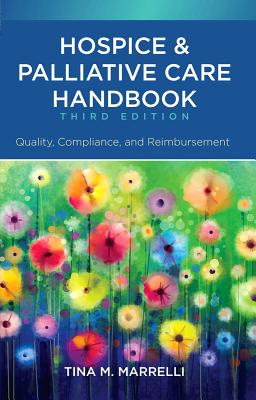
Hospice & Palliative Care Handbook, Third Edition: Quality, Compliance, and Reimbursement
Description
The goal of this book is to help hospice clinicians, team members, and managers meet quality, coverage, and reimbursement standards and requirements in daily practice and operations and in documentation activities. The Hospice Care Guidelines or problem-specific topics are organized alphabetically for easy identification and retrieval of needed information. This information can then be individualized for your hospice patient/family and used throughout the clinical record. It can even serve as a basis for a common glossary in interdisciplinary (IDG) discussions and meetings. It is formatted and designed for easy review for care and care planning-related activities. The following information refers to the specifically numbered entries in each of the eight Hospice Care Guidelines.
- General Considerations. This area contains general information about the health system problem and designated topic in relation to hospice care. There may also be symptoms listed as the basis for hospice care and care planning.
- Eligibility Considerations. This section provides information to help support medical necessity from a quality and payer perspective. Hospice team members should stay apprised of changing regulatory information and should look to their specific Medicare Administrative Contractors (MACs) and their supervisors for more information.
- Potential Diagnoses ICD-10-CM Diagnostic Coding. The International Statistical Classification of Diseases and Related Health Problems 10th Revision (ICD-10-CM) is a coding of diseases and signs, symptoms, abnormal findings, complaints, social circumstances, and external causes of injury or diseases, as classified by the World Health Organization (WHO). There are specific coding rules and conventions in the official coding manual that must be followed, and these rules may not be included in online websites or EMR software. Consult with a credentialed coder for any questions related to accurate coding. In this section, there are code ranges listed for that specific body system.
- Safety Considerations. This section lists the general kinds of safety concerns that may impact hospice care, based on diagnoses, or the care guidelines listed. The information listed in safety considerations is to be used upon assessment and throughout the care and care planning
- Skills and Services Identified. This section lists and identifies the hospice team members and some of their specialized functions and interventions based on the patient's/family's diagnoses or problems and their unique circumstances. This section assists with the individualization of care, care planning, and documentation. These services include registered nurse, hospice aide, social worker, volunteer(s), spiritual counselor, and other services. This information is provided as a list to assist in the identification of needed hospice care and services and assists team members by identifying possible interventions and care based on the team member's education and professional scope of practice.
- Patient, Family, and Caregiver Educational Needs. This section identifies care regimens that contribute to safe and effective care at home between the hospice team member's visits. This is a list of possible educational needs. This information is not all-inclusive and must be based on the patient's and family's unique circumstances and needs.
- Specific Tips for Quality, Safety, Eligibility, and Reimbursement. These tips contribute to clear, specific documentation of care and care planning-related processes.
- Quality Metrics. The questions listed in this section were created to help clinicians and managers identify possible areas for coverage and improvement of care and related processes.

